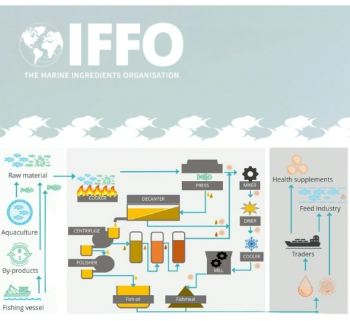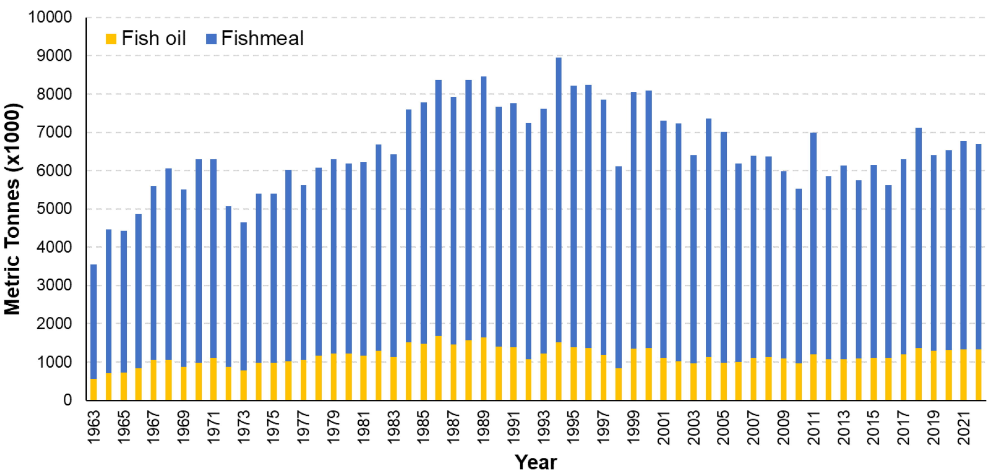|

As the aquaculture industry has evolved over the years, becoming the fastest-growing animal protein production sector
Moving towards holistic assessments of aquaculture feed: IFFO comments on a new major review
 WORLDWIDE WORLDWIDE
Tuesday, June 25, 2024, 02:00 (GMT + 9)
The leading scientific journal in fisheries science, Reviews in Fisheries Science and Aquaculture, has just published a review analysing the evolution of sustainability metrics for the marine ingredients sector*.
As the aquaculture industry has evolved over the years, becoming the fastest growing animal protein production sector, so have the metrics used to measure the use of marine ingredients. In this review, the authors look at the origin of those metrics, their assumptions, and limitations and propose a path forward.

Global fishmeal and fish oil production from 1963 to 2022 (data IFFO Citation2024).
A true reflection of environmental sustainability?
A range of sustainability metrics has emerged over the years to calculate the various efficiencies of the use of feed in animal production (terrestrial livestock and aquaculture) and more specifically the utilisation of the marine ingredient content of that feed. The ones commonly used in the marine ingredients sector include eFIFO (economic Fish In : Fish Out), FFDR (Forage Fish Dependency Ratio), FIFO (Fish In : Fish Out), and FCR (Feed Conversion Ratio).
The authors note that those metrics do not provide a true reflection of the feed sector’s environmental sustainability, by failing to consider the differences between a well-managed or poorly managed fishery. Unlike some of the food species, the forage fish species, which make of the majority of the biomass used for marine ingredients, are typically small, fast-growing, early maturing fish, with a tendency towards single stock populations, all of which make modeling and management more straightforward than many of the stocks of larger and longer lived species targeted for direct human consumption. The 2024 edition of the Food and Agriculture Organisation’s State of the World’s Fisheries and Aquaculture report indicates that “Areas with catches oscillating around a globally stable value since 1990, associated with the dominance of pelagic, short-lived species has the highest percentage (68%) of biologically sustainable stocks”.
.png) Therefore, to provide a true reflection of a feed’s environmental sustainability, those metrics should capture that, in some cases, the use of marine raw materials as feed is often the best way to retain nutrients within our food chain. Resources that by nature of either their scale or desirability as food, can still make an important contribution to the human food supply. “By feeding such resources to animals which go on to become our food, those nutrients ultimately still get transferred along the food chain to us” notes Dr Brett Glencross, the lead author of the paper. Therefore, to provide a true reflection of a feed’s environmental sustainability, those metrics should capture that, in some cases, the use of marine raw materials as feed is often the best way to retain nutrients within our food chain. Resources that by nature of either their scale or desirability as food, can still make an important contribution to the human food supply. “By feeding such resources to animals which go on to become our food, those nutrients ultimately still get transferred along the food chain to us” notes Dr Brett Glencross, the lead author of the paper.
A path forward
The review suggests a path forward, through the use of a shared metric system that can be applied to grains, marine ingredients and every other feed ingredient. Life cycle assessment (LCA) analyses were considered the most practical and robust option for use as a shared metric system. LCA consists of a holistic approach to assess the sustainability of the use of anything that requires the use of land, water and energy, and other resources, allowing all feed ingredient resources to be compared on an equivalent basis, in alignment with the agreed standards proposed by the European Union in their Product Environmental Footprint Categorization Rules (PEFCR) and those also of the Global Feed Life Cyle-Assessment Institute (GFLI).
As part of the LCA process, the partitioning of impacts between co-products (e.g., meals and oils), needs to be considered when the flow of a material or energy is split along its life cycle.
“Using this framework, it becomes easier to understand the role that marine ingredients play in the aquaculture sector: they are being used more as strategic ingredients at key points in aquaculture production cycles, with a trend towards optimizing their nutritional contributions, and ensuring we maximize the efficiency of their use. This helps us to retain more of those valuable nutrients within our food chain.” Dr Brett Glencross concludes.
* Glencross, B. D., Bachis, E., Robb, D., & Newton, R. (2024). The Evolution of Sustainability Metrics for the Marine Ingredient Sector: Moving Towards Holistic Assessments of Aquaculture Feed. Reviews in Fisheries Science & Aquaculture, 1–17. https://doi.org/10.1080/23308249.2024.2337426
Source: IFFO
[email protected]
www.seafood.media
|



